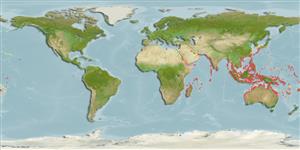Teleostei >
Clupeiformes (Herrings) >
Dorosomatidae (Gizzard shads and sardinellas)
Etymology: Herklotsichthys: After Janus Adrian Herklots, Australian ichthyologist, 1820-1872.
More on author: Rüppell.
Environment: milieu / climate zone / depth range / distribution range
生态学
海洋; 淡水; 半咸淡水 礁区鱼类; 深度上下限 0 - 13 m (Ref. 82332). 熱帶; 39°N - 33°S, 29°E - 166°W (Ref. 188)
Indo-Pacific: widespread in Indian Ocean and western Pacific, including entire eastern coast of Africa, Madagascar, Mauritius eastward to Japan, eastern Australia, and Samoa (Ref. 188). Introduced into Hawaii, apparently by accident, and now abundant (Ref. 188). At least one country reports adverse ecological impact after introduction.
印度-西太平洋: 廣泛分佈, 東非,馬達加斯加,模里西斯向東至日本,澳洲東部,美屬薩摩亞。 引入夏威夷中了 - 顯然地由於意外事件 - 在那裡它現在很豐富。 (出版的大多數的先前資料被稱為 Herklotsichthys punctatus). 至少一個國家報告引入後的不利的生態衝擊。
Length at first maturity / 大小 / 重量 / 年龄
Maturity: Lm 12.3, range 7 - 17 cm
Max length : 25.0 cm SL 雄鱼/尚未辨别雌雄; (Ref. 48635); common length : 10.0 cm SL 雄鱼/尚未辨别雌雄; (Ref. 188)
背棘 (总数) : 0; 背的软条 (总数) : 16 - 23; 臀棘: 0; 臀鳍软条: 15 - 21. Diagnosis: Body slender, its depth 18 to 30% of standard length; presence of two fleshy outgrowths on the hind margin of the gill opening; sharp belly with keeled scutes, 16-19 pre-pelvic and 12-14 post-pelvic scutes (Ref. 188, 3259). The presence of elongate wing-like scales underneath the normal paired pre-dorsal scales separate it from all other species except the two Australian species with prominent black spots on the flank, Herklotsichthys koningsbergeri and Herklotsichthys Species A, and the unspotted Herklotsichthys Species B, which has dusky tips to dorsal and caudal fins and more lower gill rakers, 36-42 vs. 33-36 in H. quadrimaculatus (Ref. 188). Flank silvery with an electric blue line preceded by two orange spots (Ref. 188).
在成对的前背部的鳞片的下面细长翼状的鳞片除了 H. koningsbergeri 以外区隔它和所有的其他种,而且 Herklotsichthys 种一在侧面与有对背鳍与尾鳍鳍与更多的下鳃耙的暗色尖端的 Herklotsichthys 种 B 上哪里有突出的黑色斑点。 侧面银色的有被前面有被位于每个鳃盖上的二个橘色的斑点的一条铁青色线。
Adults form schools near mangroves, shallow coastal bays and lagoons during the day and moves further offshore into deeper water by night (Ref. 188, 48635); at depths of 0-13m (Ref. 58302, 82332). Known in mills around in large schools under wharves or along sandy beaches in protected bays (Ref. 26367). Pelagic (Ref. 58302). Feeds on zooplankton, mainly at night, chiefly copepods in juvenile stages, but larger prey as adults (chaetognaths, polychaetes, shrimps and small fishes) (Ref. 188). Breeds during its first year and probably survives only a few months after maturity (Ref. 188). Marketed fresh and dried salted (Ref. 188). Usually parceled in leaves and baked in a motu oven. Do not recover quite as quickly as other species of baitfish after heavy fishing (Ref. 26367).
在白天期间形成鱼群红树林附近,浅滩近岸海湾与泻湖而且进一步移动离岸进入较深的水域夜晚.(参考文献 188,48635) 在在附近在码头下面的大群鱼群的压榨机或在遮蔽的内湾中沿着沙滩.(参考文献 26367) 主要在晚上觅食浮游动物, 主要地桡足类幼生, 与当成鱼时, 吃较大的猎物 (毛颚类动物,多毛类动物,虾与小鱼). 在它的第一的年期间进行繁殖而且可能只存活几个月成熟后。 在市场上销售生鲜或乾渍了。 (参考文献 188) 通常在一个 motu 烤箱中的树叶与烧烤中分配。 无法完全恢复在大量的渔捞之后像其他种的诱饵鱼一样的很快地.(参考文献 26367)
Oviparous (Ref. 205). Breeds during its first year and probably survives only a few months after maturity (Ref. 188).印度-西太平洋: 廣泛分佈, 東非,馬達加斯加,模里西斯向東至日本,澳洲東部,美屬薩摩亞。 引入夏威夷中了 - 顯然地由於意外事件 - 在那裡它現在很豐富。 (出版的大多數的先前資料被稱為 Herklotsichthys punctatus). 至少一個國家報告引入後的不利的生態衝擊。
Whitehead, P.J.P., 1985. FAO Species Catalogue. Vol. 7. Clupeoid fishes of the world (suborder Clupeoidei). An annotated and illustrated catalogue of the herrings, sardines, pilchards, sprats, shads, anchovies and wolf-herrings. FAO Fish. Synop. 125(7/1):1-303. Rome: FAO. (Ref. 188)
人类利用
渔业: 低经济; 诱饵: usually
工具
特别资料
下载 XML
网络资源
Estimates based on models
Preferred temperature (Ref.
123201): 24.9 - 29.3, mean 28.5 °C (based on 3173 cells).
Phylogenetic diversity index (Ref.
82804): PD
50 = 0.5002 [Uniqueness, from 0.5 = low to 2.0 = high].
Bayesian length-weight: a=0.00977 (0.00598 - 0.01598), b=3.08 (2.94 - 3.22), in cm total length, based on LWR estimates for this species & (Sub)family-body (Ref.
93245).
营养阶层 (Ref.
69278): 3.6 ±0.4 se; based on diet studies.
Generation time: 1.1 ( na - na) years. Estimated as median ln(3)/K based on 1
growth studies.
回复力 (Ref.
120179): 高度, 族群倍增时间少于 15个月 (K=2.6).
Fishing Vulnerability (Ref.
59153): Low vulnerability (17 of 100).
Climate Vulnerability (Ref.
125649): High vulnerability (58 of 100).
Nutrients (Ref.
124155): Calcium = 121 [63, 259] mg/100g; Iron = 1.42 [0.68, 2.55] mg/100g; Protein = 19.8 [18.5, 21.1] %; Omega3 = 0.215 [0.106, 0.453] g/100g; Selenium = 40.7 [18.6, 93.2] μg/100g; VitaminA = 42.4 [13.2, 139.7] μg/100g; Zinc = 1.82 [1.16, 2.83] mg/100g (wet weight);
